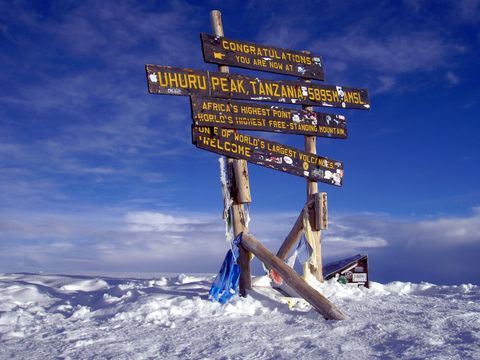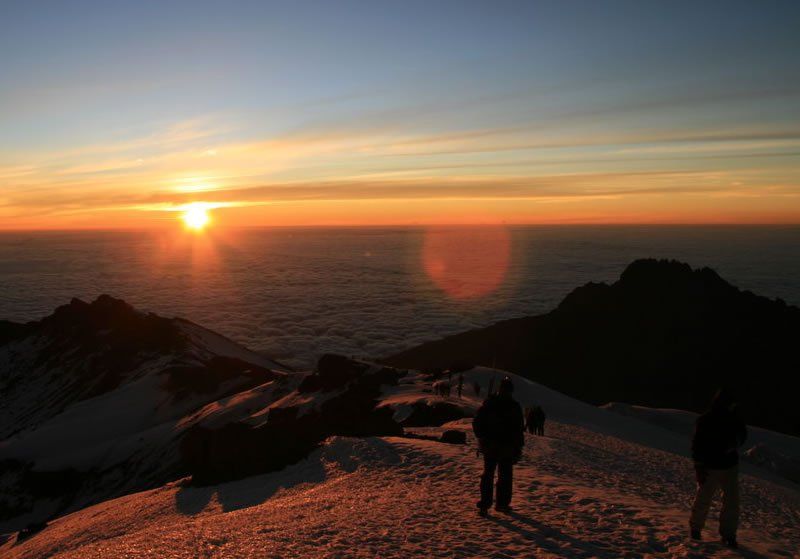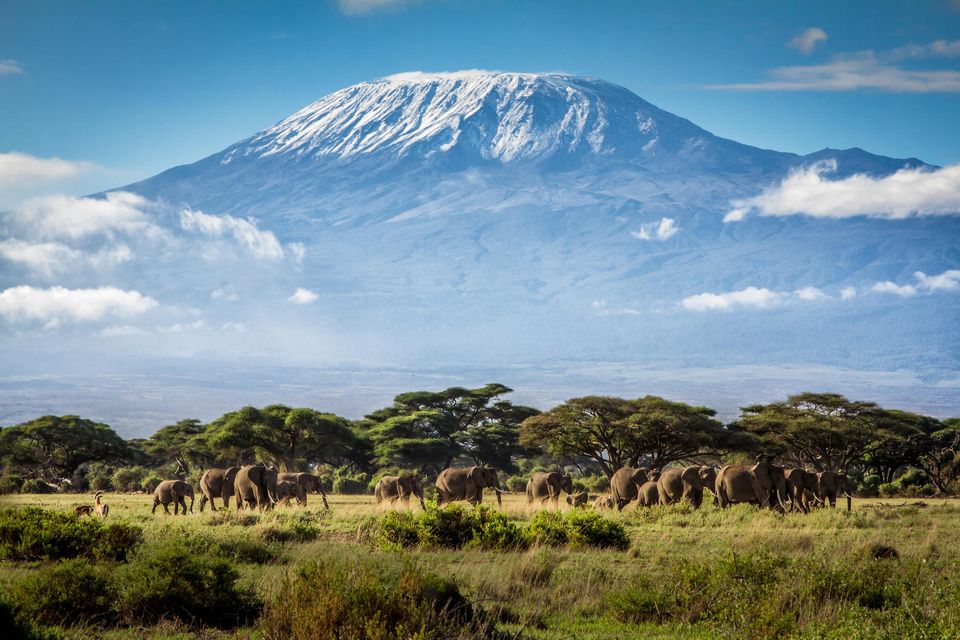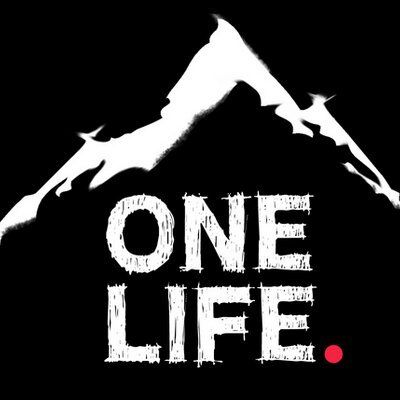Climbing Kilimanjaro
The rules for beating Kilimanjaro were to walk ‘pole, pole’ (slowly in Swahili), rest/eat/drink a lot, and be confident, positive and determined. Sometimes the ‘pole, pole’ pace seemed almost comical, as our feet inched forward step by step, but it’s necessary in order for the body to acclimatize.
Who are you
Chris Flack – Expedition Co-ordinator Kilimanjaro NZ
The Challenge
Climbing Kilimanjaro
How long did it take
6 days (August 1st – 6th)
What is the distance
About 55 km / 34 miles
How much did it cost
Your looking at around £2,400
Who is the organiser

What was it like
The first three days were relatively easy strolls through magnificent scenery. The pine plantations thinned out into alpine plains, the twin peaks of Mawenzi and Kilimanjaro towering above us. We were treated to stunning sunrises and sunsets each day, with views that literally took the breath away (though, that could also have been the increasing altitude!).
The rules for beating Kilimanjaro were to walk ‘pole, pole’ (slowly in Swahili), rest/eat/drink a lot, and be confident, positive and determined. Sometimes the ‘pole, pole’ pace seemed almost comical, as our feet inched forward step by step, but it’s necessary in order for the body to acclimatize. Kilimanjaro loomed overhead – and we were constantly reminded of our destination. Porters carried 20kgs of luggage up the trail – our gear, tents, food, water. I constantly marveled at their strength, as most of them wore backpacks as well as balancing extra weight on their heads.
I managed to drop my camera down a long-drop toilet on the way up – not my finest moment. There was high-drama as the porters and guides worked together using various contraptions, head torches out, peering into the dim hole. A hook on the end of a tent pole was finally used to haul it out, but suffice to say the camera doesn’t work anymore!
The fourth day was a 6 hour walk in the morning up to the Kibo Huts – at 4700m. The afternoon was spent trying to rest up for the big summit climb. At 11pm we gathered in the mess tent – almost ready to go. I was wearing two pairs of thermal long-johns, leggings and wet weather trousers. On top, I had a singlet, a long-sleeved merino, another thermal, an alpaca-wool jumper, down jacket, wet weather jacket, scarf, another neck warmer, a woolen hat, the hood from my jacket, two pairs of gloves and I was still cold. The air was frozen and the wind whipped through our bodies despite the layers.
Just about midnight we set off. We trudged in the darkness – zig-zigging up the mountainside on switch-backs that seemed to go forever. I had my ipod on for a bit, jigging away in a bid to keep warm (and distracted) to old Kiwi band the Fast Crew’s; “Uplift me, as long as I’ve got my music with me, I can’t stop rhyming, stop climbing, I can’t stop ’til I’ve got this song that’s in my head. Let’ go – are you ready?” Let’s go.” The scree was slippery – two steps up, one step back. Two steps up, one step back. In my head I chanted “keep walking. Keep walking. One more step. You can do it.” I breathed warm air through my gloves to stop my fingers from freezing, and pulled my scarf up around my face to protect it from the chill. The darkness was punctuated with light from our head-lamps. Looking down the path, they shone like glow-worms, but I tried not to look at the lights bobbing up the mountain-side for a thousand meters above me – that was too disheartening.
For days I’d been singing as we walked – anything I could think of that was mountain-related: “Climb Every Mountain,” “Ain’t No Mountain High Enough,” “She’ll be coming ‘Round the Mountain,” etc, but that summit morning I had nothing, no spare breath to sing. But luckily the guides did. “Kilimanjaro, Kilimanjaro, Kilimanjaro,” they sang, walking beside us and behind us. “Don’t sleep, don’t sleep,” they’d call. “You can do it! It’s a piece of cake.”
We walked on, ‘pole pole’ – leaving two of the group to walk slower with other guides, because they were struggling with altitude sickness. It wasn’t long before everyone was feeling it. I looked behind at Rhys – a Kiwi living in London. “How are you doing, mate?” I asked. “Struggling,” he replied.
Argene, a few climbers behind, looked wasted already. Up ahead, I could see Janak – an Englishman – swaying as he walked. Paul, a Brit living in NZ – walked close behind him, holding a hand out to steady him on the steep incline. I could hear another climber being sick; most of us had bloody noses. I can tell you one thing, altitude sickness is brutal.

For some unknown reason I was the only one not affected. The team joked later that because I’m tall – the guides had dubbed me “mba twiga (the singing giraffe) – I am used to higher altitudes than anyone else! But despite the sickness, and the bone-aching exhaustion, we trekked on.
Six hours later we reached “Gillman’s Point” – just in time for sunrise. We gasped as we reached the top – the first summit – and saw the world curving around below us, the sky gold and blue and orange all at once as the sun began to rise above the cotton-wool clouds that spread towards the horizon.
We’d made it, sort of. We still had a three hour round trip to the true summit – Uruhu Peak at 5895m, but at least we’d finished with most of the uphill. I surveyed everyone’s faces. There was pride, smiles – but mostly plain exhaustion. We raised our cups of hot tea: “To Christchurch,” I said. Everyone repeated, “To Christchurch,” and stood quietly.
The sun was up now and light bounced off the glaciers around the rim of the crater. The scenery was incredible – the glaciers and deep crater, Mawenzi peak poking its head through the clouds – but we were almost too tired to notice. Almost there. We were grimy from the dusty walk up – dirt streaked across our faces and covered our clothes. We just had to get to the summit. Some climbers were still being sick, others were feeling slightly delirious, and can’t remember the walk around the crater.
At the summit we all collapsed on the ground, wiped out. There were tears and hugs, of course, but it took 5 minutes or so for us all to gather enough energy even to do that. We had made it. We took photos, and shook hands in congratulation, but it wasn’t long before the first climber pleaded “can we go now?”
Eager to go lower, to breathe easier, to feel better. We gathered our layers, and began the slow walk back. As we descended, each meter brought some relief from the team’s sickness, but it was another 4 hours before we were back at camp. My knees were shot from “skiing” down the scree on the way back down the mountain.
We had lunch and a short rest – before packing up and walking a little over 3 hours to where we’d sleep that night. I try to be a positive person, but those hours dragged and it took every piece of ‘get up and go’ that I had to keep walking. I wanted to sit at the side of the path and not move for hours. I had cramp in my calf, my knee ached, my thigh muscles were tight and I had a pinched nerve in my hip. But we had to keep walking.
I’m not sure if I’ll ever see a sweeter sight than camp that early evening. We celebrated two of the teammate’s 30th birthdays, before bed and one of the best, and most-deserved, sleeps in a long time.
Christchurch, we know you are enduring a lot as you cope with the aftermath of the quakes. Kilimanjaro was a test of our own endurance and we did it for you, raising almost $18,000 for the quake fund in the process. It was one of the toughest things I will probably ever do – but it was worth it.

How should you train
Walking, swimming and more walking
Any other useful hints / links
Make sure you cut your toe nails
Go for it – a once in a lifetime experience
View More Articles
Services List
-
Land This is a text area. Writing in paragraphs lets your visitor find what they are looking for quickly and easily. Edit the text in the list editor.
Land -
Water Expeditions This is a text area. Writing in paragraphs lets your visitor find what they are looking for quickly and easily. Edit the text in the list editor.
Water Expeditions -
Ice Expeditions This is a text area. Writing in paragraphs lets your visitor find what they are looking for quickly and easily. Edit the text in the list editor.
Ice Expeditions
